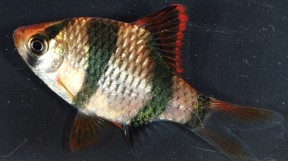Puntigrus navjotsodhii
SynonymsTop ↑
Systomus navjotsodhii Tan 2012
Etymology
Puntigrus: formed from part of the generic name Puntius and tigrus, a word created to sound like the Latin word tigris, meaning ‘tiger’, in allusion to the barred colour pattern and the common name ‘tiger barb’ used for some members.
navjotsodhii: named for Professor Navjot S. Sodhi (1962-2011), “for his inputs to conservation and ecological research in Southeast Asia, also for his considerable contributions and services to the editorship of the Raffles Bulletin of Zoology”.
Classification
Order: Cypriniformes Family: Cyprinidae
Distribution
Known only from the upper Katingan and Barito river basins in Kalimantan Tangah (Central Kalimantan) province, Indonesian Borneo.
Type locality is ‘Borneo: Central Kalimantan: Katingan basin, Mendawai sub-basin: hill stream at buffer zone of Bukit Raya–Bukit Baka National Park, ca. 200 m asl (00°44.91’S, 112°15.85’E)’.
Habitat
The type series was collected from a small clear-water stream with a pH of 6.0, forming a series of riffles and deeper pools, with a maximum width of 5 metres and depth ranging from 10 cm to 1 metre. The substrate was composed of sand gravel and rocks, with some leaf litter and overhanging marginal vegetation.
Syntopic fishes included members of the genera Barbonymus, Barbodes, Crossocheilus, Garra, Hampala, Mystacoleucus, Rasbora, Gastromyzon, Pangio, Leiocassis, Hemibagrus, Glyptothorax, Channa, and Mastacembelus.
Maximum Standard Length
At least 48 mm.
NotesTop ↑
This species is unknown in the aquarium hobby, with the trade largely reliant on commercially-produced ‘tiger barbs’ of questionable origin.
It is distinguished from congeners by the following combination of characters: 4 broad, black bars up to 5 scales wide, bars 2-3 curved posteriorly; anterior ¾ of dorsal-fin black, anterior-most portion red and posterior margin red in live specimens; pelvic fins almost entirely red in live specimens; lips black; lateral line complete, with 20-21 pored scales in the lateral series 20–21; body deep, depth at dorsal-fin origin 53.6–59.2% SL; caudal peduncle deep, 18.4–19.9% SL.
The genus Puntigrus was raised by Kottelat (2013) in order to accommodate a group of species formerly referred to as the ‘Puntius tetrazona group’. Other members are P. tetrazona, P. navjotsodhii, P. pulcher, and P. partipentazona, of which the first three are native to western, central, and eastern Borneo, respectively, and the latter to Indochina.
This assemblage is diagnosed by possession of a unique colour pattern comprising 4 black bars on a pale body, and black pigmentation on at least the basal half of the dorsal-fin. The anteriormost body bar passes through the eye, the second is anterior to the pelvic-fin base, the third is above the anal-fin and continues onto it, and the posteriormost is at the caudal-fin base.
The following combination of characters also aid in identification, although individually they are not unique to the genus: body rhomboid, deep; last simple dorsal-fin ray serrated posteriorly; rostral barbels absent; maxillary barbels present; lips smooth and thin, postlabial groove interrupted medially; lateral line complete or incomplete; 18–23 lateral line scales; 9½–10½ [5½/1/3–4½] scale rows between dorsal-fin origin and ventral midline anterior to pelvic-fin base; 12–14 circumpeduncular scale rows; 8–9 rakers on first gill arch.
The genus Puntius was previously viewed as a polyphyletic catch-all containing over 100 species, but this situation has been largely resolved since the turn of the century.
References
- Tan, H. H., 2012 - Raffles Bulletin of Zoology, Supplement 25: 285-289
Systomus navjotsodhii, a new cyprinid fish from central Kalimantan, Borneo. - Kottelat, M., 2013 - Raffles Bulletin of Zoology Supplement 27: 1-663
The fishes of the inland waters of southeast Asia: a catalogue and core bibiography of the fishes known to occur in freshwaters, mangroves and estuaries.


